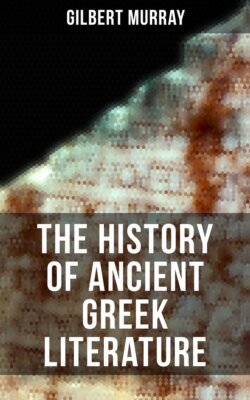Читать книгу The History of Ancient Greek Literature - Gilbert Murray - Страница 14
На сайте Литреса книга снята с продажи.
HYMNS OR PRELUDES
ОглавлениеIt was a custom in epic poetry for the minstrel to 'begin from a god,' generally from Zeus or the Muses.4 This gave rise to the cultivation of the 'Pro-oimion' or Prelude as a separate form of art, specimens of which survive in the so-called Homeric 'Hymns,' the word ὓμνος having in early Greek no religious connotation. The shortest of these preludes merely call on the god by his titles, refer briefly to some of his achievements, and finish by a line like, "Hail to thee, Lord; and now begin my lay," or, "Beginning from thee, I will pass to another song."5 The five longer hymns are, like Pindar's victory songs, illustrations of the degree to which a form of art can grow beyond itself before it is felt to be artistically impossible. The prelude was developed as a thing apart until it ceased to be a prelude.
The collection which we possess contains poems of diverse dates and localities, and the tradition of the text is singularly confused. The first 546 lines, for instance, are given as one hymn 'to Apollo.' But they comprise certainly two hymns: the first (1-178) by an Ionic poet, on the birth of the Ionian God in the floating island of Delos; the second by a poet of Central Greece, on the slaying of the great Earth-serpent, and the establishment of the Dorian God at Delphi. Further, these two divisions are not single poems, but fall into separate incomplete parts. Athenæus actually calls the whole 'the hymns to Apollo.' The Ionic portion of this hymn is probably the earliest work in the extant collection. It is quoted as Homer's by Thucydides (iii. 104), and Aristophanes (Birds, 575), and attributed by Didymus the grammarian to the rhapsode Kynæthus of Chios; which puts it, in point of antiquity, on a level with the rejected epics. The hymn to Hermes partly dates itself by giving seven strings to the original lyre as invented by that god. It must have been written when the old four-stringed lyre had passed, not only out of use, but out of memory. The beautiful fragment (vii.) on the capture of Dionysus by brigands looks like Attic work of the fifth or fourth century B.C. The Prelude to Pan (xix.) may be Alexandrian; that to Ares (viii.) suggests the fourth century A.D.
In spite of their bad preservation, our Hymns are delightful reading. That to Aphrodite, relating nothing but the visit of Aphrodite to Anchises shepherding his kine on Mount Ida, expresses perhaps more exquisitely than anything else in Greek literature that frank joy in physical life and beauty which is often supposed to be characteristic of Greece. The long hymn to Demeter, extant in only one MS., which was discovered last century at Moscow 'among pigs and chickens,' is perhaps the most beautiful of all. It is interesting as an early Attic or Eleusinian composition. Parts are perhaps rather fluent and weak, but most of the poem is worthy of the magnificent myth on which it is founded. Take one piece at the opening, where Persephone "was playing with Okeanos' deep-breasted daughters, and plucking flowers, roses and crocus and pretty pansies, in a soft meadow, and flags and hyacinth, and that great narcissus that Earth sent up for a snare to the rose-face maiden, doing service by God's will to Him of the Many Guests. The bloom of it was wondeiful, a marvel for gods undying and mortal men; from the root of it there grew out a hundred heads, and the incensed smell of it made all the wide sky laugh above, and all the earth laugh and the salt swell of the sea. And the girl in wonder reached out both her hands to take the beautiful thing to play with; then yawned the broad-trod ground by the Flat of Nysa, and the deathless steeds brake forth, and the Cronos-born king, He of the Many Names, of the Many Guests; and He swept her away on his golden chariot." The dark splendour of Aidôneus, "Him of the Many Thralls, of the Many Guests," is in the highest spirit of the saga.
